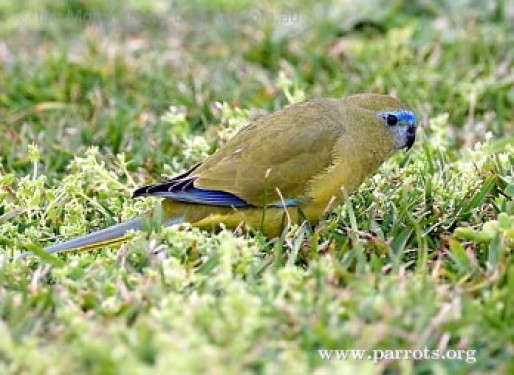
Rock Parrot
[order] PSITTACIFORMES | [family] Psittacidae | [latin] Neophema petrophila | [authority] Gould, 1841 | [UK] Rock Parrot | [FR] Perruche des rochers | [DE] Klippensittich | [ES] Periquito Roquero | [NL] Rotsparkiet | [copyright picture] Ian Montgomery
Subspecies
Monotypic species
Genus
The genus Neophema is an Australian genus of broad-tailed parrots with six or seven species. They are small parakeets with a more or less dull green basic color with some contrasting colorful patches, and are commonly known as grass parrots. The genus has some sexual dichromatism, males having more and brighter color patches.
Physical charateristics
The Rock Parrot is a stocky, plump grass-parrot endemic to southern Australia. It has a dull brownish olive-green body shading to a yellow abdomen with a diagnostic blue forehead and face. The shoulders are narrowly edged in light and dark blue and it has a slender tail that is pale blue above and yellowish below. The Rock Parrot is tame, quiet and unobstrusive in its general behaviour. It rarely forms large flocks and is usually seen in small groups. The Rock Parrot is almost exclusively terrestrial but commonly perches in dense shrubbery and occasionally shelters under rocks.
| wingspan min.: | 22 | cm | wingspan max.: | 24 | cm |
| size min.: | 22 | cm | size max.: | 23 | cm |
| incubation min.: | 18 | days | incubation max.: | 19 | days |
| fledging min.: | 28 | days | fledging max.: | 32 | days |
| broods: | 1 | eggs min.: | 3 | ||
| eggs max.: | 4 |
Range
Australasia : South, Southwest Australia. The Rock Parrot lives on the rocky coastline of south and west Australia. There are two major populations, in the east along the coast from Kingston to Ceduna in South Australia and in Western Australia from Cape Arid National Park to Geraldton.
Habitat
The Rock Parrot is restricted to coastlines and offshore rocky islands, frequenting windswept coastal dunes, mangroves, saline swamps and rocky islets. It is seldom seen more than a few hundred metres from the sea.
Reproduction
The Rock Parrot breeds mostly on off-shore islands, nesting in a rock crevice, tunnel or abandoned seabird nesting burrow, or on a rocky ledge often behind a ‘curtain’ of succulent shrubs. The females incubates the eggs while the male feeds her by regurgitation, an act which is also ritualised in courtship. Breeding season is froms August to December, the clutch size iw 4-5 eggs which are incubated for about 18 days; young fledge after another 30 days.
Feeding habits
The Rock Parrot feeds on seeds and fruits of a wide variety of grasses, rushes, shrubs and salt-tolerant plants. It forages quietly, mainly in the early morning and late afternoon.
Video Rock Parrot
httpv://www.youtube.com/watch?v=MEIJWRgSJfU
copyright: Nick Talbot
Conservation
This species has a very large range, and hence does not approach the thresholds for Vulnerable under the range size criterion (Extent of Occurrence <20,000 km2 combined with a declining or fluctuating range size, habitat extent/quality, or population size and a small number of locations or severe fragmentation). Despite the fact that the population trend appears to be decreasing, the decline is not believed to be sufficiently rapid to approach the thresholds for Vulnerable under the population trend criterion (>30% decline over ten years or three generations). The population size has not been quantified, but it is not believed to approach the thresholds for Vulnerable under the population size criterion (<10,000 mature individuals with a continuing decline estimated to be >10% in ten years or three generations, or with a specified population structure). For these reasons the species is evaluated as Least Concern.

Migration
The Rock Parrot is mainly sedentary, moving about locally in pairs or small flocks during the breeding season, but birds on offshore islands tend to disperse to nearby coasts in autumn and winter.
Distribution map

